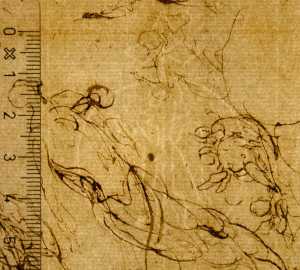Specifications
| Title | Composition Study for 'The Holy Trinity in Paradise with Saints and Angels' |
|---|---|
| Material and technique | Pen and brown ink |
| Object type |
Drawing
> Two-dimensional object
> Art object
|
| Location | This object is in storage |
| Dimensions |
Height 210 mm Width 259 mm |
|---|---|
| Artists |
Draughtsman:
Alessandro Maganza
Previously attributed: El Greco |
| Accession number | S 21 (PK) |
| Credits | Loan Stichting Museum Boijmans Van Beuningen (former Koenigs collection), 1940 |
| Department | Drawings & Prints |
| Acquisition date | 1940 |
| Creation date | in circa 1600-1610 |
| Watermark | Standing angel in a circle surmounted by a trefoil (50 x 42 mm, near the center, on P5 of 8P, vH, cropped folio), very similar to the watermark in another Maganza drawing in Rotterdam (inv. S 19) and the one in Piccard Online AT3800-PO-21415 (Trento 1590). [see image] |
| Inscriptions | 'greco' (on the removed mount, below right, pencil), '186' (idem, below left, pencil), '16' (idem, top center, pencil) |
| Collector | Collector / Franz Koenigs |
| Mark | F.W. Koenigs (L.1023a on removed mount) |
| Provenance | Sir Archibald Alison (1792-1867), Glasgow (in an album); Art dealer Luigi Grassi (1858-1937, L.1171b), Florence (from the album, probably dismembered by him); Franz W. Koenigs (1881-1941, L.1023a), Haarlem, acquired in 1930 (attributed to El Greco); D.G. van Beuningen (1877-1955), Rotterdam, acquired with the Koenigs Collection in 1940 and donated to Stichting Museum Boijmans Van Beuningen |
| Research |
Show research Italian Drawings 1400-1600 |
| Literature | Tietze/Tietze-Conrat 1944, pp. 27, 292 under no. A 1754 and A 1757 (mid 17th-c.); Wethey 1962, p. 153 (Venetian Mannerist); Byam Shaw 1976, under no. 840; Byam Shaw 1983, under no. 252; Paris 1996, under no. 61; Matarrese 2002, pp. 51, 67, 80, fig. 6; Boschini/De Boer 2008, pp. 165-166, fig. 18 |
| Material | |
| Object | |
| Geographical origin | Italy > Southern Europe > Europe |
| Place of manufacture | Vicenza > Veneto region > Italy > Southern Europe > Europe |
Do you have corrections or additional information about this work? Please, send us a message

























